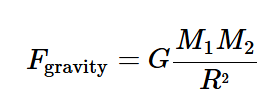chapter 3.3 newton's universal law of gravitation & 3.4 orbits in the solar system
1/9
There's no tags or description
Looks like no tags are added yet.
Name | Mastery | Learn | Test | Matching | Spaced |
|---|
No study sessions yet.
10 Terms
gravity
the force that attracts a body towards the centre of the earth, or towards any other physical body having mass
newton believed that Earth’s gravity might extend as far as the Moon and produce the force required to curve the Moon’s path from a straight line and keep it in its orbit
newton hypothesised that gravity is not limited to Earth, but that there is a general force of attraction between all material bodies
whenever there are masses in the universe, they will interact via the force of gravitational attraction
never becomes 0 (implied by newton’s law)
universal law of gravitation
newton hypothesised that there is a universal attraction among all bodies everywhere in space
he had to find a precise mathematical description of that gravitational force that had to dictate that the planets move exactly as Kepler had described them to
also, that gravitational force had to predict the correct behavior of falling bodies on Earth, as observed by Galileo
he concluded that the magnitude of the force of gravity must decrease with increasing distance between the Sun and a planet (or any two objects) and that gravitational attraction between two bodies must be proportional to their masses

Fgravity= gravitational force between two objects
M1 and M2= masses of the two objects
R= their separation
G= ‘universal gravitational constant’

weight
depends on the local force of gravity -
a body’s relative mass or the quantity of matter contained by it, giving rise to a downward force
acceleration on Earth vs Moon
the Moon is 60 Earth radii away from the centre of Earth
if gravity (thus acceleration) gets weaker with distance squared, the acceleration the Moon experience should be a lot less for the object compared to Earth
The acceleration should be (1/60)2 = 1/3600 (or 3600 times less—about 0.00272 m/s)
Kepler’s relationship between the orbital period of a planet’s revolution and its distance from the Sun reformulated by newton


eccentricity of planets
most eccentric orbit; Mercury (0.21)
rest of planets; less than 0.1
orbital period lengths
planets closest to the Sun have the shortest orbital period, increasing as distance from the Sun increases
Mercury (88 Earth days), thus it has the highest orbital speed (48km/s)
Neptune (165 years), average orbital speed of 5km/s
planetary orbits
confined to a common plane (near the plane of Earth’s orbit (ecliptic)
asteroid
small rocky body orbiting the sun
have smaller semimajor axes than comets
the majority of asteroids lie between 2.2 and 3.3 AU (asteroid belt) —> middle gap between the orbits of Mars and Jupiter
comet
a celestial object consisting of a nucleus of ice and dust and, when near the sun, a ‘tail’ of gas and dust particles pointing away from the sun
tend to have larger orbits with greater eccentricity than asteroids
eccentricity of their orbits = 0.8 or greater
according to Kepler’s second law, they spend most their time far from the Sun, moving slowly
as they approach perihelion (point of an orbit which is closest to the Sun) , the comets speed up and whip through the inner parts of their orbits more rapidly